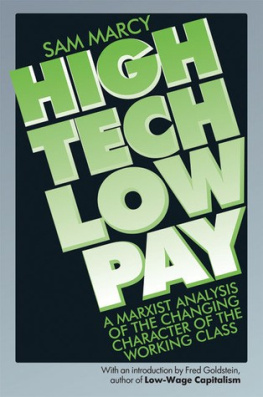Sam Marcy - High Tech, Low Pay: A Marxist Analysis of the Changing Character of the Working Class
Here you can read online Sam Marcy - High Tech, Low Pay: A Marxist Analysis of the Changing Character of the Working Class full text of the book (entire story) in english for free. Download pdf and epub, get meaning, cover and reviews about this ebook. year: 1984, genre: Politics. Description of the work, (preface) as well as reviews are available. Best literature library LitArk.com created for fans of good reading and offers a wide selection of genres:
Romance novel
Science fiction
Adventure
Detective
Science
History
Home and family
Prose
Art
Politics
Computer
Non-fiction
Religion
Business
Children
Humor
Choose a favorite category and find really read worthwhile books. Enjoy immersion in the world of imagination, feel the emotions of the characters or learn something new for yourself, make an fascinating discovery.
High Tech, Low Pay: A Marxist Analysis of the Changing Character of the Working Class: summary, description and annotation
We offer to read an annotation, description, summary or preface (depends on what the author of the book "High Tech, Low Pay: A Marxist Analysis of the Changing Character of the Working Class" wrote himself). If you haven't found the necessary information about the book — write in the comments, we will try to find it.
Sam Marcy: author's other books
Who wrote High Tech, Low Pay: A Marxist Analysis of the Changing Character of the Working Class? Find out the surname, the name of the author of the book and a list of all author's works by series.
High Tech, Low Pay: A Marxist Analysis of the Changing Character of the Working Class — read online for free the complete book (whole text) full work
Below is the text of the book, divided by pages. System saving the place of the last page read, allows you to conveniently read the book "High Tech, Low Pay: A Marxist Analysis of the Changing Character of the Working Class" online for free, without having to search again every time where you left off. Put a bookmark, and you can go to the page where you finished reading at any time.
Font size:
Interval:
Bookmark:
This study is an elaboration of a thesis developed in a memorandum on "The Changed Character of the Working Class" written in the summer of 1984 and submitted for publication to Workers World newspaper in October 1984. At that time we said that high technology, that is, the scientific-technological revolution, had become such an enormous economic factor that it had changed the social composition of the U.S. working class.
The basic content of the change has been a massive general shift of the workers away from relatively high-skilled, high-paid jobs into lower-skilled, lower-paid service jobs. Because of this shift, the social weight of the lower-skilled, lower-paid workers, made up mostly of Black and Latin people and women, has become preponderant in the general workforce of the U.S.
At the time of that writing there was already abundant data to confirm our general analysis. It may have appeared, however, that the data was still of only a tentative and conditional character and therefore inconclusive.
However, a new flood of statistics based on studies of not only the 1980 U.S. census but updated reports since then has lent further support to our thesis. One of these valuable studies to which we refer later is by Ward Morehouse and David Dembo of the Council on International and Public Affairs and includes a series of special reports, the first written in October 1984 under the title "The Underbelly of the U.S. Economy: Joblessness and Pauperization of Work in America."
Finally, an official report issued February 6, 1986, by the U.S. Congressional Office of Technology Assessment fully confirms our analysis. While the full study containing some 450 pages of data was not available at the time of the writing of this book, abundant excerpts were published in many newspapers throughout the country.
A principal finding of this report was that in the five years from 1979 to 1984 as many as 11.5 million workers either lost their jobs or shifted to lower-paying service jobs. "Nearly half of all workers displaced from 1979 to 1984 worked in manufacturing industries such as steel, auto, industrial equipment, textiles and apparel. [As many as] 45% have taken a pay cut and two-thirds of those were earning less than 80% of their former income." The report went on to state, "Given the pace of technological and structural economic change, [many more workers] may be left behind."
With regard to the nature of the shift away from the heavy industries, the report said that 95% of the new jobs created in the period studied were lower-paid service jobs. In 1984, the report said, the average hourly wage in manufacturing was $9.18. However, the average hourly wage for production and non-supervisory workers in all service-producing sectors was $7.52. It would be correct to assume that the gap between the higher wage scale and the lower ones has since widened and not narrowed.
This is a social trend wholly unanticipated by those who had expected the great advances and discoveries in science and technology to have brought about "upward mobility." This is what was looked for from the scientific and technological revolution. Instead, all of the studies disclose a clear trend in the opposite direction.
Instead of raising the level of Black, Latin, women and other oppressed workers in capitalist society to that of the higher paid, more privileged, so-called aristocratic sector of workers, the scientific-technological revolution is mercilessly and ruthlessly leveling down and demolishing the higher social stratum in the working class and reducing it to the level of the lower paid.
While the apologists for the ruling class are celebrating this new condition of the working class, they stop short at drawing the deeper social and political significance it has for the process of the newly emerging social composition of the working class. The growing demolition of vast sections of highly paid workers and their sinking to the level of the more oppressed sections spells out a new constellation of internal forces in the working class. It will, for one thing, fundamentally alter the relationship between Black and white workers.
This developing relationship bodes ill for capitalist apologists because it discloses a new material basis for classwide solidarity and even a revolutionary potential for the working class. The new composition of the working class will give it a more homogeneous character and limit greatly the racist, hierarchical stratification upon which the ruling class has been able to thrive and which it has cultivated and promoted all these years.
It will inevitably shift the political balance away from the more privileged layers of the working class in favor of the hitherto underprivileged, unrepresented and more scattered oppressed workers. The internal political relations between the different strata of the working class will become more harmonized on the level of working class politics. This new trend in the working class goes contrary to the historical tendency of capitalist development in the past.
The scientific-technological revolution is a truly global phenomenon and should not be assessed solely on the basis of its national manifestation in the U.S. Its influence stretches from one end of the globe to the other. Its effects can be felt in Tokyo and Sweden, in France and Mexico, all over the globe. (Its development in the socialist countries is not the object of our study here.)
It is a phenomenon that cannot be reversed. Those who bemoan its existence today must look to the future, not to a return to the past, which in any case is impossible.
Of course, it is possible for the growth of the productive forces, of science and technology, to slow down and possibly stagnate, as happened in the period immediately after the great economic crisis of the early 1930s. Even then, however, research and development continued, if at a slower pace. But what was developed slowly in the laboratories at that time took on a feverish momentum once the buildup began for the Second World War.
It is wrong to underestimate high technology by viewing it as only a narrow sector of the economy. This was the conclusion of the study by the United Auto Workers (UAW) research department printed in the May-June 1985 Research Bulletin and referred to earlier: "High-tech firms represent only a small portion of our economy and with high projected growth fewer than a million jobs are likely to be created in the next decade in high-tech firms."
That may be true enough. The Congressional Office of Technology Assessment report confirmed it: "Jobs in computer and semiconductor manufacturing are unlikely to rescue many workers from traditional manufacturing jobs because employment in these industries is small." And of course, the total number of jobs in computer and semiconductor industries is small by comparison with the overall workforce, which counts in the tens of millions.
But this is an evasion of the fundamental issue involved in the scientific-technological revolution. While it is a very narrow sector, its influence is decisive for all sectors of the economy.
These technological changes alter fundamental social trends and bring to the fore new political forces. It is therefore wholly inadequate to point to the mere number of workers directly involved in this particular narrow sector without showing its overwhelming influence in all phases of the capitalist economy. Moreover, high technology has fueled the enormous growth of the military-industrial complex.
It need only be recalled that in July 1985 the heretofore leading civilian corporation, General Motors, acquired Electronic Data Systems (EDS) and its computer services. The whole purpose was to acquire high technology and move this civilian sector of the economy closer to the military-industrial complex. Even such a homespun company as Singer Sewing Machine, a household name for decades, as of February 1986 abandoned the business of manufacturing sewing machines by announcing that it would dismantle its plants (at who knows what cost to the workers) and move completely into the aerospace industry. Now its only connection to sewing machines will be the marketing of "Singer" machines made by other companies.
Font size:
Interval:
Bookmark:
Similar books «High Tech, Low Pay: A Marxist Analysis of the Changing Character of the Working Class»
Look at similar books to High Tech, Low Pay: A Marxist Analysis of the Changing Character of the Working Class. We have selected literature similar in name and meaning in the hope of providing readers with more options to find new, interesting, not yet read works.
Discussion, reviews of the book High Tech, Low Pay: A Marxist Analysis of the Changing Character of the Working Class and just readers' own opinions. Leave your comments, write what you think about the work, its meaning or the main characters. Specify what exactly you liked and what you didn't like, and why you think so.








